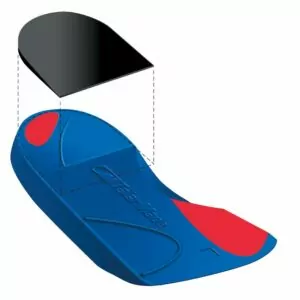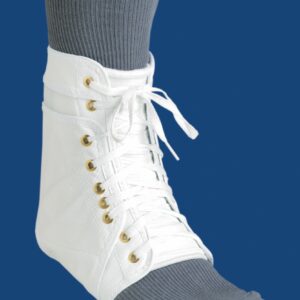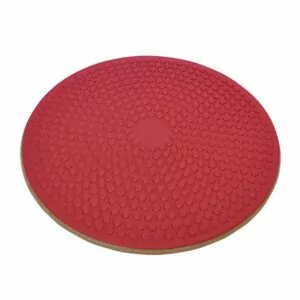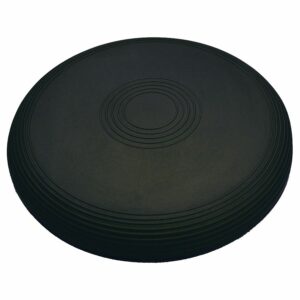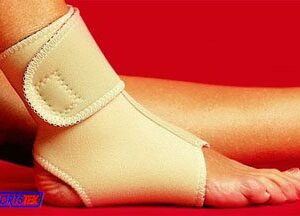Ankle Synovitis
Updated:
(Also known as Post-Traumatic Ankle Synovitis)
What is ankle synovitis?
Ankle synovitis is a condition characterized by inflammation of the soft tissue lining the ankle joint capsule, known as the synovium, with subsequent ankle swelling, pain and stiffness.
The lower leg comprises of 2 long bones, known as the fibula and the tibia, which are situated beside each other (figure 1). These bones join with each other and the talus to form the ankle joint (figure 1). The ankle joint comprises of strong connective tissue surrounding the joint known as the joint capsule. The joint capsule is lined with specialized tissue known as the synovium (or synovial membrane) which is responsible for secreting lubricating fluid (synovial fluid) into the ankle joint, therefore reducing friction during ankle movements.
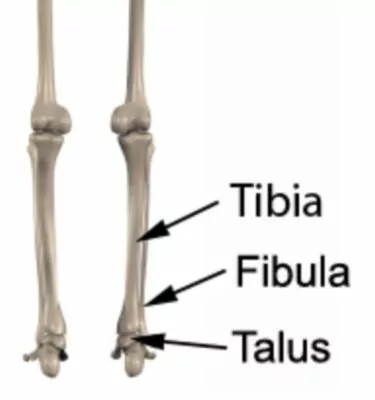
Following an ankle injury, swelling may accumulate within the ankle joint. This may place pressure on the synovium particularly when combined with excessive weight bearing activity and ankle movements. This may irritate the synovium causing it to become inflamed. In addition, the synovium may become inflamed directly due to injury. When the synovium becomes inflamed, the condition is known as ankle synovitis.
Cause of ankle synovitis
Some degree of synovitis may occur with most ankle injuries, however, when it is persistent, it is then referred to clinically, as ‘Ankle Synovitis’. Ankle synovitis usually occurs following an ankle injury such as a serious ankle sprain and may be particularly common in patients who attempt to return to weight bearing activity too early following the injury (particularly if the ankle is still swollen or stiff). The condition may also occur due to repetitive strain associated with walking or running excessively, especially with pronated (flat) feet or on uneven surfaces. Ankle synovitis may also occur in the patient with chronic ankle instability or the patient with a history of recurrent ankle sprains, who is undertaking regular weight bearing sport or activity.
Signs and symptoms of ankle synovitis
Patients with ankle synovitis typically experience an ache or pain at the front and / or sides of the ankle. Occasionally pain may be felt in the back of the ankle. Symptoms may develop suddenly due to a specific incident or gradually over time. Most commonly, ankle synovitis will present following an ankle sprain that does not fully recover and causes ongoing pain, swelling, stiffness and difficulty with weight bearing.
Symptoms are typically worse in the morning (or with rest following weight bearing activity) and may present as pain and stiffness that slowly improves as the patient warms up (e.g. following a morning shower). Symptoms may also be aggravated during walking or running especially on slopes or on uneven surfaces. The patient may also experience swelling as well as tenderness on firmly touching the ankle joint.
Treatment for ankle synovitis
Most patients with ankle synovitis heal well with appropriate physiotherapy. The success rate of treatment is largely dictated by patient compliance. One of the key components of treatment is that the patient rests sufficiently from any activity that increases their pain until they are symptom free (crutches, taping, the use of heel wedges or an ankle brace may be required). This allows the body to begin the healing process in the absence of further tissue damage. Once the patient can perform these activities pain free, a gradual return to these activities is indicated provided there is no increase in symptoms.
Ignoring symptoms or adopting a ‘no pain, no gain’ attitude is likely to lead to the condition becoming chronic. Once chronic, healing slows significantly resulting in markedly increased recovery times and an increased likelihood of future recurrence. Immediate appropriate treatment in all patients with ankle synovitis is vital to ensure an optimal outcome.
Diligently following the R.I.C.E. Regime with regular icing and anti-inflammatory medication may help to significantly reduce inflammation in the initial phase of ankle synovitis and can significantly hasten recovery. A graduated flexibility, balance and strengthening program under direction from a physiotherapist is vital to ensure an optimal outcome. Hands on treatment from the physiotherapist, involving techniques such as massage and mobilization, can also accelerate recovery at the appropriate time.
In the final stages of rehabilitation, a gradual return to activity or sport should occur under guidance from the treating practitioner and provided symptoms do not increase. In those patients whose injury is due to ankle instability, taping or bracing may be indicated during this phase.
Contributing factors to the development of ankle synovitis
There are several factors which can predispose patients to developing ankle synovitis. These need to be assessed and corrected with direction from a physiotherapist and may include:
- ankle instability
- poor flexibility (particularly of the ankle joint, the subtalar joint or the calf muscles)
- inappropriate or excessive training
- poor foot biomechanics
- inappropriate footwear
- muscle weakness
- a history of chronic ankle sprains
Physiotherapy for ankle synovitis
Physiotherapy treatment is vital to hasten the healing process, ensure an optimal outcome and reduce the likelihood of injury recurrence in all patients with this condition. Treatment may comprise:
- soft tissue massage
- electrotherapy (e.g. ultrasound)
- anti-inflammatory advice
- joint mobilization
- taping
- bracing
- the use of crutches
- the use of heel wedges
- ice or heat treatment
- dry needling
- exercises to improve strength, flexibility and balance
- education
- activity modification advice
- biomechanical correction
- footwear advice
- a graduated return to activity program
Prognosis of ankle synovitis
Most patients with this condition heal well with appropriate physiotherapy. Minor cases of this condition that are identified and treated early can usually settle within days to weeks. In more severe or chronic cases, recovery can be a lengthy process and may take several months in patients who have had their condition for a long period of time. In these instances, often a corticosteroid injection into the ankle joint is often considered to assist with accelerating recovery and can be performed by a sports medicine doctor.
Early physiotherapy treatment is therefore vital to hasten recovery and ensure an optimal outcome in all patients with ankle synovitis.
Other Intervention for ankle synovitis
Despite appropriate physiotherapy management, a small percentage of patients with this condition do not improve adequately. When this occurs the treating physiotherapist or doctor can advise on the best course of management. This may involve further investigation such as an X-ray, Ultrasound, CT scan or MRI, corticosteroid injection, pharmaceutical intervention or a review by a specialist who can advise on any procedures that may be appropriate to improve the condition. A review with a podiatrist for the prescription of orthotics and appropriate footwear advice may also be indicated.
Exercises for ankle synovitis
The following exercises are commonly prescribed to patients with this condition. You should discuss the suitability of these exercises with your physiotherapist prior to beginning them. Generally, they should be performed 3 times daily and only provided they do not cause or increase symptoms.
Foot and Ankle Up and Down
Move your foot and ankle up and down as far as possible and comfortable without pain (figure 2). Repeat 10 – 20 times provided there is no increase in symptoms.
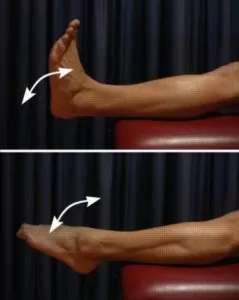
Foot and Ankle In and Out
Move your foot and ankle in and out as far as possible and comfortable without pain (figure 3). Repeat 10 -20 times provided there is no increase in symptoms.
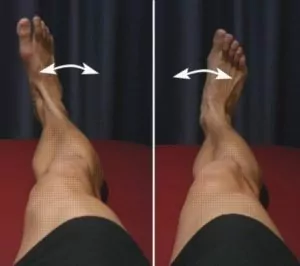
Lunge Stretch
With your hands against the wall, place your leg to be stretched in front of you as demonstrated (figure 4). Keep your heel down. Gently move your knee forward over your toes as far as possible and comfortable without pain. Hold for 5 seconds and repeat 10 times at a mild to moderate stretch provided there is no increase in symptoms.
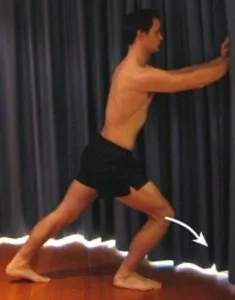
Find a Physio for ankle synovitis
Find a physiotherapist in your local area who can treat this condition.
More information
- View more Ankle Flexibility Exercises.
- View Ankle Strengthening Exercises.
- View Balance Exercises.
- View our Ankle Diagnosis Guide.
Physiotherapy products for ankle synovitis
Some of the most commonly recommended products by physiotherapist for patients with ankle synovitis include:
To purchase physiotherapy products for ankle synovitis click on one of the above links or visit the PhysioAdvisor Shop.
Become a PhysioAdvisor Member
-
 Individual Membership (12 Months)$59.95 for 1 year
Individual Membership (12 Months)$59.95 for 1 year -
 Individual Membership (3 Months)$39.95 for 3 months
Individual Membership (3 Months)$39.95 for 3 months -
 Individual Membership (Yearly)$49.95 / year
Individual Membership (Yearly)$49.95 / year -
 Individual Membership (Monthly)$15.95 / month
Individual Membership (Monthly)$15.95 / month

Link to this Page
If you would like to link to this article on your website, simply copy the code below and add it to your page:
<a href="https://physioadvisor.com.au/injuries/ankle/ankle-synovitis”>Ankle Synovitis – PhysioAdvisor.com</a><br/>PhysioAdvisor offers detailed physiotherapy information on ankle synovitis including causes, symptoms, diagnosis, treatment, exercises, physiotherapy products and more...
Return to the top of Ankle Synovitis.

